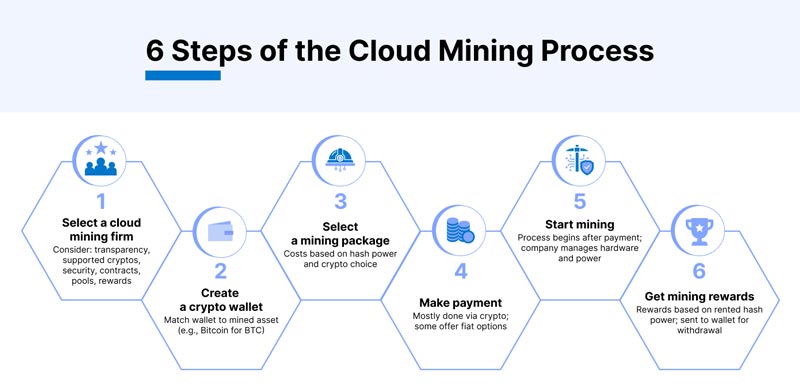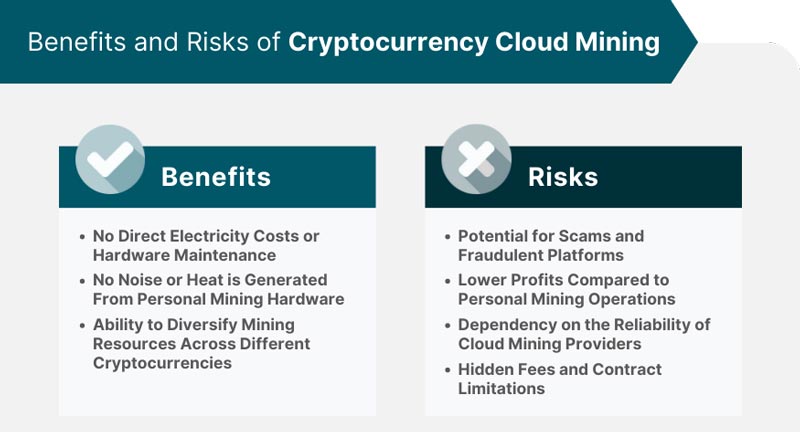What you are about to read:
In the world of cryptocurrency, mining has been a fundamental process that validates transactions and secures decentralized networks. Traditionally, mining involved setting up powerful physical hardware with significant electricity consumption, making individual participation nearly impossible. However, with the emergence of cloud mining, a new paradigm has surfaced, offering a simpler and more convenient way for individuals to participate in this ecosystem. In this article, Brokerland will explore cloud mining from A to Z.
Understanding Mining in Crypto
Before delving into cloud mining, it’s crucial to understand the fundamental principles of mining cryptocurrencies. Previous articles have thoroughly examined and explained the process of Bitcoin mining. In decentralized networks like Bitcoin, Ethereum, and others, transactions are categorized into blocks.
Miners compete to solve complex mathematical problems, and the first one to solve it earns the right to add the block to the blockchain. This process, known as Proof of Work (PoW), not only secures the network but also rewards miners with new digital currencies as an incentive for their mining efforts.
Historically, individual miners invested in specialized hardware like ASIC (Application-Specific Integrated Circuit) or GPU (Graphics Processing Unit) and set up mining operations at home or in dedicated facilities. However, this approach comes with challenges such as high initial costs, ongoing maintenance, and the need for a stable power source.
What is Cloud Mining?
Cloud mining demonstrates a difference from the traditional mining model by providing a more accessible and resource-efficient alternative. In cloud-mining, individuals can remotely rent computational power from data centers equipped with specialized mining hardware. Outsourcing mining activities to third-party service providers has gained popularity due to various reasons, including accessibility and resource efficiency.
Cloud mining operates by users registering with a provider, selecting a mining plan, and paying a fee to rent computational power. The provider takes care of setting up hardware, maintenance, electricity costs, allowing users to participate in mining without the need for specialized knowledge or infrastructure.
The mining process itself remains the same. Rented computational power is directed towards solving complex mathematical problems, and rewards in the form of newly mined digital currencies are distributed among participants based on their computational contribution.
It’s crucial to note that while cloud mining simplifies the mining process for users, it requires a level of trust in the service provider. Users rely on the provider’s integrity for accurate reward distribution and transparent operations. This emphasizes the importance of trust and finding a reputable provider.
Just as in various scams and manipulations such as Ponzi scheme, stop hunting, pump and dump, and various fraudulent activities prevalent in the prop trading and broker scam landscape, caution must be exercised in selecting a cloud mining provider.
Accessibility
Cloud mining allows individuals to participate in mining without the need for significant investment in hardware, space, and electricity. This reduces entry barriers, making mining accessible to a broader audience.
Cost Efficiency
Traditional mining setups often involve high initial costs and ongoing expenses. With cloud-mining, users can pay a fee to rent computational power, eliminating the need to purchase, set up, and maintain physical hardware. This cost-effective model can be attractive to those looking to enter the mining space without committing to significant capital expenditures.
Flexibility in Cloud Mining
Cloud mining platforms offer flexible contract durations. Users can choose short-term or long-term contracts based on their preferences and risk tolerance. This flexibility allows dynamic participation in activities without the restriction of a fixed investment horizon.
Geographical Independence
Since cloud mining operations are hosted remotely in data centers, users are not limited by geographical constraints. They can participate in mining activities from any location worldwide, eliminating the need for proximity to hardware.
Reduced Technical Complexity in Cloud Mining
Setting up and maintaining mining rigs requires technical expertise. Cloud mining eliminates technical complexities associated with hardware management, allowing users to focus solely on the mining process without dealing with hardware issues.
Joining a Cloud Mining Service
Joining a cloud mining service involves several steps, and it’s essential to approach this process with thorough research and necessary diligence. Here is a step-by-step guide on how to join a platform:
Research and choose a reputable cloud mining provider
Conduct thorough research on various cloud mining providers. Look for reviews, user feedback, and information about their history. Consider factors such as the provider’s reputation, transparency, fees, contract terms, and their duration of operation.
Creating a User Account
Visit the official website of the selected cloud mining provider, much like opening an account with a Forex broker or a crypto exchange. Look for the “Sign Up” or “Register” option and create a user account. Typically, you’ll need to provide a valid email address and create a secure password.
Identity Verification (if necessary)
Similar to crypto exchanges without identity verification, some cloud mining platforms may not require identity verification. However, some might request identity verification for security purposes, involving personal information and, in some cases, identity documents.
Explore Mining Plans
After creating an account, log in to the platform and explore the available mining plans. Different plans may offer varying levels of hash power, contract durations, and associated costs. When selecting a plan, consider your budget, risk tolerance, and mining goals.
Deposit Funds
Once you’ve chosen a mining plan, deposit funds into your account. These mining platforms usually accept payments in crypto (Bitcoin, Ethereum, etc.), fiat currencies (USD, EUR, etc.), or stablecoins like USDT and USDC. Some platforms may offer discounts or bonuses for larger deposits, so explore promotional offers.
Purchase Cloud Mining Contract
With funds in your account, proceed to purchase a cloud-mining contract based on your chosen plan. Review contract terms, including contract duration, maintenance fees, and other relevant details.
Monitor Mining Activity
Once your cloud mining contract is active, monitor your mining activity through the platform’s interface. Some platforms provide real-time statistics on hash power, mined coins, and payouts.
Withdraw Your Earnings
As you collect the mined currency, you can usually withdraw your earnings from the platform. Consider the withdrawal options and associated fees when transferring funds to your personal crypto wallet, whether it’s a crypto wallet for Android like Trust Wallet or a crypto hardware wallet like Ledger. Be extremely careful during the transfer to avoid any mistakes, as crypto transactions are irreversible.
Risks and Considerations
It’s crucial to note that while cloud mining offers accessibility and convenience, it comes with inherent risks. Always exercise caution, choose reputable providers, and stay informed about potential returns. Additionally, stay updated on digital currency market changes to make informed decisions about your mining activities.
- Issues Related to Trust: The decentralized nature of cryptocurrencies emphasizes trustless systems. However, cloud mining introduces an element of trust to the service provider. Users must conduct thorough research and choose reputable providers with a transparent operational history.
- Profitability Factors: Crypto markets are dynamic, and mining profitability is influenced by factors such as network difficulty, market prices, and transaction fees. Cloud mining contracts often specify a fixed hash power, and users need to carefully assess potential returns against contract costs.
- Contract Terms: Cloud-mining contracts come with specific terms and conditions, including contract duration, maintenance fees, and potential limitations. Users should read and understand these terms carefully before entering into a contract.
- Market Dynamics: The cryptocurrency market is known for its volatility. Market price fluctuations can significantly impact the profitability of mining operations. Users should be prepared for the inherent uncertainties associated with the crypto space.
- Long-Term Viability: The long-term viability of cloud mining providers is a crucial consideration. Users should evaluate the reputation of the provider, financial stability, and commitment to maintaining competitive services over time.
Summary
Cloud mining represents a modern approach to digital currency mining, democratizing access to the essential aspect of decentralized networks. While offering a more accessible entry point for individuals, a careful examination of risks, contract terms, and the reputation of service providers is vital.
As the outlook for digital currencies continues to evolve, cloud-mining becomes an attractive option for those seeking participation in the world of digital assets without the complexities of traditional mining setups. Like any investment, due diligence and a precise understanding of associated risks are essential for informed decision-making in this dynamic and exciting space.












